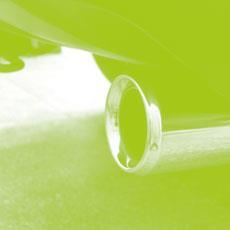Urban logistics is impeded by congestion, a lack of kerbspace, the need for cleaner air and restrictions on size and noise, all against a backdrop of increased demand.
Freight is now higher on the agenda and helped by more inter-agency co-ordination than before, but progress is painstaking.
Worldwide, air pollution is said to kill more people than Aids and malaria combined, and it is certainly credited with a high death toll in some UK cities.
About 40,000 early deaths and a £27.5bn annual bill has seen ministers declaring air pollution a national emergency.
The government had planned to roll out Clean Air Zones (CAZ) in Birmingham, Leeds, Nottingham, Derby and Southampton by 2020.
The zones were graded A-E, with each adding a different traffic element: HGVs, buses, taxis and so on, but none of the original CAZ policies targeted the UK’s 12 million diesel cars.
Emissions measurements
However, the government now has to produce a much more aggressive plan for tackling air pollution after the High Court twice ruled that its current policies were so poor they were illegal.
The High Court found that the government was basing its policy on lab-based emissions measurements (typically on cars and vans) which it knew bore little resemblance to the levels of emissions pumped out in daily use, and that its timetable lacked urgency.
ClientEarth, the group of environmental lawyers that took the government to court, says it will now have to be far tougher on diesel. “Euro-6 was not what we thought it would be,” says a ClientEarth spokesperson.
Hard to defend
The government’s exclusion of cars from CAZs will be hard to defend.
A Leeds University study into Euro-6 cars following the VW scandal found that: “The latest generation of Euro-6 diesel cars do emit around 50% less NOx per kilometre of driving than their predecessors but still, on average, five times that permitted by the Euro-6 standard.”

Euro-6 turned the spotlight on NOx. Pre-Euro-6 vans usually produce more NOx in order to make the diesel particulate filter work more efficiently.
Euro-6 vans add a NOx trap or SCR to cut NOx emissions, and while they are 40% better than Euro-5, according to the FTA, there is still a question mark over whether they achieve the test limits in real-world driving.
Reports by Ricardo, the Low Carbon Vehicle Partnership and TfL all assert that heavy-duty Euro-6 vehicles are tested much more rigorously.
Ricardo says its heavy-duty engine testing on the road has shown emissions values between half and twice that of the allowable level, so “within extremely low conformity factors”.
The other possible outcome of the High Court ruling, which emphasised speed of implementation, is that the government resurrects its original plans for far more Clean Air Zones.
ClientEarth is calling for 16 CAZs across the UK by 2018 – something the FTA’s head of national and regional policy, Christopher Snelling, refers to as “the worst-case scenario”.
Snelling says it is hard to see diesel being acceptable anywhere on city streets by 2030. In the shorter term we will face Euro-7 but there is little more than informed speculation in terms of what will be included. CO2 will be a major focus, but NOx emissions are likely to be hammered down again as well as particulate matter (PM).
Changing behaviour
TfL senior strategy and planning manager Paul Strang says standards to push air quality improvements are “quicker and easier than measures to change behaviours”.
Andy Noble, head of heavy-duty engines at Ricardo, says: “It is almost always possible to go further in reducing emissions, and we are pursuing research on ultra-low NOx heavy-duty diesel and natural gas engines aimed at extremely low emissions of just 7% of Euro-6 for new standards in California.
"However,[with] NOx and PM we are possibly beginning to approach a stage of diminishing returns beyond Euro-6, where background pollution levels from industry and from older vehicles become the real problem.”
When emissions can go no lower and practical alternatives to diesel for heavy duty applications are still years off, what comes next?
Public policy can still focus on encouraging fleet renewal – perhaps with scrappage schemes – and encouraging after treatments. However, Strang’s reference to changing behaviours comes sharply into focus.
The historic policy focus on mitigation is increasingly giving way to reducing the demand for transport, which essentially means working with freight customers to change how and when they want their goods and effecting a range of consolidation techniques.
TfL’s freight and fleet project manager for retiming Jaz Chani admits most major retailers and logistics companies have long used consolidation as a natural efficiency measure.
Footing the bill
Consolidation centres themselves can reduce HGV movements but at the cost of greater van movements. They also rely upon businesses being prepared to co-operate on logistics and to foot the bill.
While there has been some notable progress in the public sector and construction, it remains to be seen whether other types of business will take this up.

TfL claims the use of a construction consolidation centre can cut journeys to site by 70%.
The RHA’s manager for infrastructure and security, Chrys Rampley, notes that such centres only work when adequate thought is given to access and queuing facilities for trucks.
Chani responds that the needs of freight are now being considered far more carefully in planning applications.
Rampley also says that the crucial element moving forwards will be engagement by freight customers and operators; and if any operator currently has an innovative solution, could they please share it?
Snelling warns that consolidation and retiming should not be imposed if they don’t genuinely improve efficiency. “Every politician thinks these will be a magic solution,” he says.
Previous policies have been distinctly limited in effect. The congestion charge “reduced traffic and bought space for an expanded bus network”, argues Strang.
However, the exclusion of taxis should signal a warning bell for future policies.
When the congestion charge was introduced in 2003 there were 22,500 black cabs in London.
The exact number of minicabs in 2003 is not known, but it definitely grew. In 2010, there were 50,000 minicabs and in 2015 there were 76,000, with 25,000 signed up to Uber alone: an unintended consequence of public policy.
Earlier this year the government refused once again to cap minicab numbers in the capital.
By Louise Cole













![DP World Modal Shift Programme Image[72690]](https://d2cohhpa0jt4tw.cloudfront.net/Pictures/100x67/4/9/7/17497_dpworldmodalshiftprogrammeimage72690_781836.jpg)
